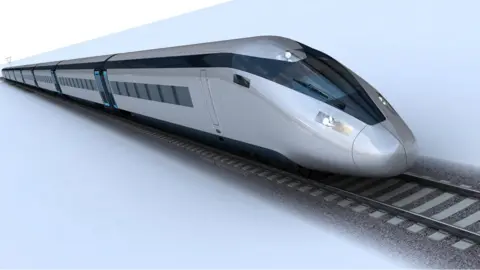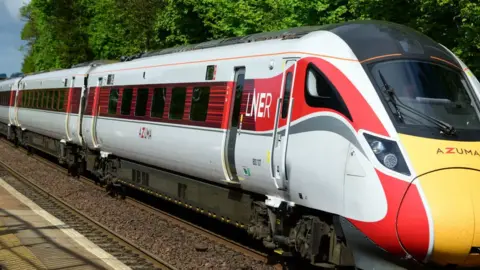Making tracks across the border

 HS2
HS2- Give and take in the new rail plans for the north of England and Midlands have created winners, losers and disappointment.
- High-speed rail plans as they affect Scotland are not much changed - with reduced travel times almost entirely because of improvements to tracks and capacity in the south. But choices are yet to be made on how fast London trains will be, depending how often they have to stop.
- The UK government is yet to set out its plans for improved transport connections across the UK's internal borders, but they could be arriving soon.
In terms of "levelling up" the left-behind bits of Britain, rail is a test case of what that means and whether it's serious.
With some give and some take, one of the more generous assessments is that UK ministers' "integrated rail" plan has delivered a very British outcome - "a half-built railway".
Without managing expectations and by pulling back on past plans, a lot of money is being deployed in the building of a lot of disappointment.
There were expectations of high speed services reaching Leeds and transforming the grim infrastructure that has long failed to link northern mill towns to the modern world.
Past plans have now been revised and costs cut.
And in the small print, note that plans will still have to go through the financial gateways, which the Treasury controls like fortifications.
So what does it mean for Scotland and links to the south?
As with air connections, remember not just to see this as a means of getting out of Scotland. Transport also brings in visitors for business and leisure, and rail is a travel option that cuts down on aviation and road emissions.
That environmental rail advantage is more important for Scotland because speed and length of journey makes the aircraft a serious competitor to the long-distance train, in a way that it rarely does in England.
Cancellation of the new high speed link between Leeds and points south could diminish the range of options for travellers linking further north with Edinburgh and the east of Scotland, particularly if journeys are to the the north of England and Midlands.
Journeys between Scotland and England have seen faster growth for destination Manchester and Birmingham than the growth for London.
All of them have been growing a lot in recent decades. The Victorian rail network that built spokes in and out of London is unlike the modern demand for services that aren't about the metropolis.
And that growth in passenger numbers is why capacity - and particularly in the southern portions of the journey, as population becomes more dense - is a constraint that has to be addressed. That can be done with more tracks, longer trains and smarter signalling, as well as faster trains.
Parallel tracks
Apart from Leeds, the impact on Scottish links with English cities is not as great as the change that will or won't take place across the north of England.
It remains the case that a journey that typically takes four and a half hours from London to Glasgow should be cut by about 50 minutes, once HS2 has reached a point near Wigan. At that point, a northbound train will transfer off high-speed tracks, and as it continues north, it won't be able to go as fast.
The east coast line, from Edinburgh through York and Peterborough to London, is to get an upgrade. That is badly needed. Rail campaigners point to ageing overhead gantries and the failure to provide sufficient electric power for the newest trains north of Newcastle, meaning that at least some of them have to switch to diesel.
 Getty Images
Getty ImagesIf the new plans for "integrated rail" do as promised on the east coast line, that could cut journey times by 20 minutes between Newcastle and London. But the plans give no indication of improvements north of the Tyne.
Rail campaigners say there could be improvements to speed up these long-distance services on tracks north of the border. Most of these would use existing line, in some cases and places adding parallel tracks so that slower trains don't get in the way of the fast ones.
That could cut Glasgow to London journeys to only three hours, but that depends how often they stop.
If the priority is to link Scotland with London in order to reduce demand for air travel, then the priority should be very few stops and the minimum possible journey time.
'Union connectivity'
A rough reckoning by the rail industry is that a cut in journey time from 4 hours 30 minutes to 3 hours 40 should knock out about half of the demand for London air links with Scotland's central belt. Taking it down to three hours could replace air travel.
But there are other priorities in the north of England. "Levelling up" means services that stop and don't hurtle past English towns in order to suit Scottish travellers.
It was recently reported that a Scottish government official had admitted to a transport conference that plans for improving rail connectivity with England have been shunted into a siding for the past couple of years. That appears to reflect a lack of co-operation between Whitehall and St Andrew's House.
Even if it has stopped its own work in high speed rail, the Scottish government remains keen on the UK government pushing on.
Said a spokesperson at Transport Scotland: "We have consistently supported HS2 from the outset and called for it to extend further north to Scotland, recognising the benefits this will bring from the improvements in the connectivity, capacity and resilience of the rail network, in addition to a welcome reduction in journey times.
"It is therefore disappointing that the ambition for HS2 has been scaled back rather than expand by bringing it north of Border."
A strategic transport projects review is expected this winter, with a 20-year time horizon.
Boris Johnson's government wants to be seen to be improving cross-border links of all sorts, and on its own terms for political reasons.
A "union connectivity review" has been long-awaited. Its first draft pointed to improvements to the road links to Northern Ireland through Scotland. It could also take on the hopes of a railway that links the new Edinburgh-Border railway with Carlisle.
Stand by for a tannoy announcement that the review will be arriving at a UK government platform in the next few weeks.
